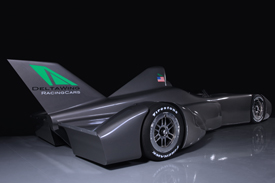The Delta Wing – Can you say tail-out driving?
Lets give a brief overview of yaw stability and look at the sensitivity of downforce to yaw.
Yaw angle is the angle a car is sideways through a corner in relation to its longitudinal axis as depicted in the diagram below.

Aerodynamic forces will tend to straighten a yaw stable car if it gets a bit sideways. For the purposes of this analysis, positive yaw moment (torque) will tend to increase the yaw angle. In other words, for a stable car we want a negative yaw moment.
You probably expect that a front heavy car is more stable in yaw then a rear heavy car and you are correct. The graph below shows the yaw moment vs. weight distribution on the front wheels. This analysis uses the familiar simple body with 2 inches of ground clearance with 5 degrees of yaw.

This car needs 87% of its weight on the front axle to be Yaw Neutral ( zero yaw moment, neither stable nor unstable). However, the majority of the weight of the Delta Wing car (72%) is on the rear wheels which means the car is going to pivot around the front axle and once that weight gets moving sideways, it will be easy to coax it further. The long nose acts as a lever arm when the car is starting to get sideways and pushes it even more sideways (it applies a positive yaw moment). Also note that yaw moment changes linearly with weight distribution.
 |
| 72% of the car weight is carried by the rear wheels of the DeltaWing car |
Because the Delta Wing car has no short chord front and rear wings, there is no loss of downforce to those wings as a car begins to go sideways. One of the reasons today's traditional open wheel car looks like it drives on rails is because if the driver were to hang out the tail, the rear wing immediately loses downforce and the car can easily spin out before the driver could catch it.
The most efficient way to drive the traditional winged open wheel car is yaw neutral, or in a line parallel to the car's longitudinal axis.
Ben Bowlby told us that Delta Wing simulations show that a driver can step the rear out up to 10 degrees positive yaw and maintain reasonable control. As soon as the rear steps out the large fin at the rear immediately experiences a side force from the airflow pushing the rear of the car back toward yaw neutral.
Because the Delta Wing car has so much weight at the rear of the car, if it didn't have the large rear fin to push the car back to yaw neutral, once a driver started to swing that heavy rear sideways (pivoting around the front axle) it just might keep on going and they would spin out.
So yes, the rear fin is great for sponsor logos or a large car number, but in fact it was put there to help the driver maintain a controlled sideways slid through the corner at up to about 10 degrees yaw.
A low speeds, through say a hairpin corner, the rear fin won't provide much help because the airflow velocity over the car will be low, but at high speeds, the rear fin will help the driver keep the car's tail out without snapping out of control suddenly.
And if simulations are correct, it works, and the fans will be in for some exciting tail-out driving.
